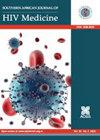喂养“生”母乳的极低出生体重婴儿的围产期艾滋病毒感染
IF 1.6
4区 医学
Q4 INFECTIOUS DISEASES
引用次数: 0
摘要
HIV暴露的极低出生体重(VLBW)婴儿(≤1500 g)被认为是围产期母婴HIV传播(MTCT)的高危人群。过去,他们接受配方奶粉,以防止与母乳有关的艾滋病毒传播。这剥夺了母乳的好处,从而使婴儿暴露于坏死性小肠结肠炎(NEC)的风险。从2010年开始,“生”母乳(rMOM)被推荐给那些母亲接受产前抗逆转录病毒治疗(ART)的足月婴儿。同时,根据国家预防母婴传播方案,这名婴儿接受了抗逆转录病毒(ARV)预防。目的了解HIV暴露的VLBW婴儿在接受rMOM和婴儿ARV预防治疗后4-6周龄围产期HIV感染的累积发生率。方法回顾性观察审计,在一个机构进行了超过3年。研究人群包括hiv暴露的VLBW婴儿,他们从出生到出院都接受奈韦拉平预防和rMOM。4-6周的HIV- pcr阳性用于确认母婴HIV传播。结果在2010年至2013年期间入院的80名符合条件的婴儿中,63名(79%)暴露于产前抗逆转录病毒治疗。78例(97.5%)在4-6周时检测HIV-PCR阴性。在两名检测呈阳性的婴儿中,两人都表现出急性艾滋病毒感染的特征。其余78名接受抗逆转录病毒预防和rMOM治疗的婴儿中没有MTCT,这表明rMOM不太可能是这两名感染婴儿的感染源。结论在有婴儿预防措施的情况下,rMOM是hiv暴露的VLBW婴儿的安全喂养选择。应该强烈考虑对这些婴儿进行rMOM,因为rMOM可能提供额外的母婴福利。本文章由计算机程序翻译,如有差异,请以英文原文为准。
Peripartum HIV infection in very low birth weight infants fed ‘raw’ mother’s own milk
Background HIV-exposed very low birth weight (VLBW) infants (≤ 1500 g) are considered at high risk of peripartum mother-to-child HIV transmission (MTCT). In the past, they received formula to prevent breast milk related HIV transmission. This denied them the benefits of breast milk, thus exposing the infant to the risk of necrotising enterocolitis (NEC). From 2010, ‘raw’ mother’s own milk (rMOM) has been recommended for term infants whose mothers’ received antenatal antiretroviral therapy (ART). At the same time, the infant received antiretroviral (ARV) prophylaxis as per the National Prevention of MTCT programme. Objectives To determine the cumulative incidence of peripartum HIV infection by 4–6 weeks of age in HIV-exposed VLBW infants, who received rMOM and infant ARV prophylaxis. Method A retrospective, observational audit over 3 years at a single institution was undertaken. The study population comprised HIV-exposed VLBW infants who received both nevirapine prophylaxis and rMOM from birth until discharge. A positive HIV-PCR by 4–6 weeks of life was used to confirm maternal to infant HIV transmission. Results Of the 80 eligible infants admitted between 2010 and 2013, 63 (79%) were exposed to antenatal ART. Seventy-eight (97.5%) tested HIV-PCR negative at 4–6 weeks. Of the two infants who tested positive, both presented with features of an acute HIV infection. The absence of MTCT in the remaining 78 infants given ARV prophylaxis and rMOM suggests that rMOM is an unlikely source of infection in the two infected infants. Conclusion rMOM, in the presence of infant prophylaxis, was a safe feeding option for HIV-exposed VLBW infants. It should be strongly considered for these infants, as rMOM likely provides additional maternal and child benefits.
求助全文
通过发布文献求助,成功后即可免费获取论文全文。
去求助
来源期刊
CiteScore
2.80
自引率
11.80%
发文量
41
审稿时长
>12 weeks
期刊介绍:
The Southern African Journal of HIV Medicine is focused on HIV/AIDS treatment, prevention and related topics relevant to clinical and public health practice. The purpose of the journal is to disseminate original research results and to support high-level learning related to HIV Medicine. It publishes original research articles, editorials, case reports/case series, reviews of state-of-the-art clinical practice, and correspondence.

 求助内容:
求助内容: 应助结果提醒方式:
应助结果提醒方式:


